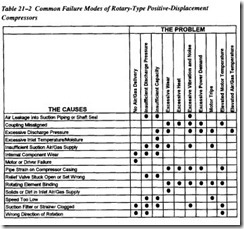Sliding-Vane Compressors
Sliding-vane compressors have the same failure modes as vane-type pumps. The dominant components in their vibration profile are running speed, vane-pass frequency, and bearing rotation frequencies. In normal operation, the dominant energy is at the shaft’s running speed. The other frequency components are at much lower energy levels. Common failures of this type of compressor occur with shaft seals, vanes, and bearings.
Shaft seals. Leakage through the shaft’s seals should be checked visually once a week or as part of every data-acquisition route. Leakage may not be apparent from the out side of the gland. If the fluid is removed through a vent, the discharge should be con figured for easy inspection. Generally, more leakage than normal is the signal to replace a seal. Under good conditions, they have a normal life of 10,000 to 15,000 hours and should routinely be replaced when this service life has been reached.
Vanes. Vanes wear continuously on their outer edges and, to some degree, on the faces that slide in and out of the slots. The vane material is affected somewhat by prolonged heat, which causes gradual deterioration. Typical life expectancy of vanes in 100-psig service is about 16,000 hours of operation. For low-pressure applications, life may reach 32,000 hours.
Replacing vanes before they break is extremely important. Breakage during operation can severely damage the compressor, which requires a complete overhaul and realign ment of heads and clearances.
Bearings. In normal service, bearings have a relatively long life. Replacement after about 6 years of operation is generally recommended. Bearing defects are usually dis played in the same manner in a vibration profile as for any rotating machine train. Inner and outer race defects are the dominant failure modes, but roller spin also may contribute to the failure.
